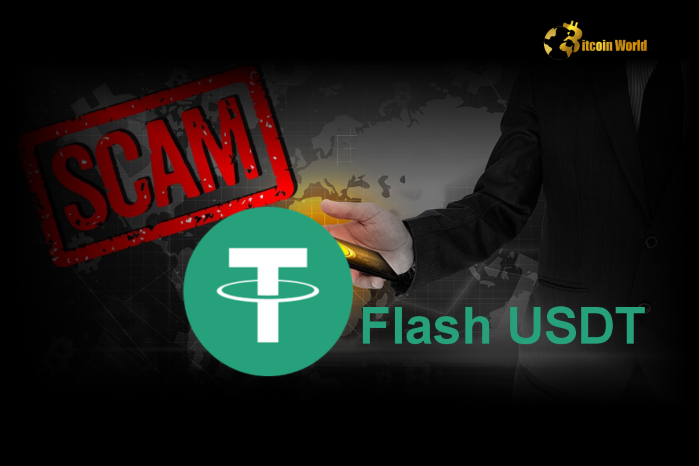Flash USDT Scam Exposed: How It Works and How to Protect Your Crypto Assets
In the world of cryptocurrency, scams targeting investors are becoming increasingly sophisticated, with the Flash USDT scam being one of the latest fraudulent schemes to hit the market. This scam specifically targets Tether (USDT), a popular stablecoin pegged to the U.S. dollar, and exploits the fast and irreversible nature of blockchain transactions to deceive unsuspecting investors. Here’s how the Flash USDT scam operates, how to spot it, and ways to protect yourself from similar frauds.
What is the Flash USDT Scam?
The Flash USDT scam is a scheme where scammers generate fake USDT tokens or create misleading transactions to make it appear as if large amounts of USDT have been transferred to a victim’s wallet. The scam often employs “flash loans” or fake token transactions that appear legitimate at first glance but are essentially valueless. Scammers then lure victims into making real payments or transfers based on the false appearance of receiving funds.
The scam can take various forms, including:
- Fake Transaction Notifications: Scammers use platforms or apps that create fake notifications, misleading victims into thinking they have received USDT.
- Flash Loan Exploits: Flash loans, which allow for quick borrowing and repayment within the same transaction, can be manipulated to create the appearance of high-value transfers or deposits.
- Fake Wallet Balances: Scammers may use counterfeit wallets that falsely display USDT balances, deceiving users into believing they have assets they do not actually own.
How the Flash USDT Scam Works
Here’s a breakdown of how the Flash USDT scam typically operates:
- Creation of Fake USDT Tokens or Transactions: Scammers generate fake USDT tokens that look like genuine ones on the blockchain or use technical exploits to create misleading transactions.
- Sending “Funds” to Victim Wallets: The scammer sends these fake tokens or initiates transactions to the victim’s wallet. The transaction may even be visible on the blockchain, which adds a layer of perceived legitimacy.
- Request for Payment or Investment: After the victim believes they have received funds, the scammer contacts them, often posing as an investment opportunity or asking for a “small” fee to release the full amount.
- Victim Sends Real Assets: Believing they have USDT in their wallet, victims are convinced to send real crypto assets to the scammer or make a real payment.
- Funds Disappear: Once the payment is made, the scammer disappears, and the victim realizes the USDT they thought they received is fake or non-existent.
Signs of a Flash USDT Scam
Identifying a Flash USDT scam early on can help you avoid becoming a victim. Here are some red flags to look out for:
- Unexpected USDT Deposits: If you receive a large or unexpected amount of USDT, be cautious. Scammers often use these fake deposits to make you believe in a windfall or an investment opportunity.
- Requests for Fees to Unlock Funds: Any request to send funds in order to “unlock” or “release” other assets is a major red flag and a common tactic used in scams.
- Fake Wallet Balance Updates: Some scammers use wallets or apps that falsely display higher balances. Always verify your balance on official platforms or block explorers to ensure the funds are legitimate.
- Unverifiable Transactions: If you see a transaction but are unable to trace it or verify its legitimacy on a reputable blockchain explorer, it’s likely a scam. Real transactions should be easily viewable on the blockchain.
How to Protect Yourself from Flash USDT Scams
Here are steps you can take to protect your digital assets from the Flash USDT scam and other similar frauds:
- Verify Transactions on Blockchain Explorers: Always check transactions on official blockchain explorers like Etherscan or Tronscan to confirm they are real and legitimate.
- Avoid Suspicious Links and Wallets: Scammers often use fake wallet apps or phishing links to mislead users. Stick to reputable wallet providers and exchanges, and avoid downloading apps from unverified sources.
- Never Send Payments to “Unlock” Funds: Any request to send a fee or additional funds to access assets is a major warning sign. Legitimate transactions do not require payments to “unlock” or access funds.
- Double-Check USDT Tokens: Only accept or trade USDT that is verified through reputable exchanges or wallet providers. Scammers may use similar token names or symbols to deceive users.
- Stay Informed of Scams: Crypto scams evolve quickly. Staying up-to-date on the latest scam types can help you recognize fraudulent schemes before falling victim.
Real-World Examples of Flash USDT Scams
The Flash USDT scam has been reported by various crypto users, particularly those using peer-to-peer (P2P) trading platforms. In one notable example, a user received a fake USDT deposit notification and was convinced to send Bitcoin (BTC) to the scammer in exchange. Once the BTC was sent, the scammer disappeared, and the USDT deposit was found to be fake. This type of scam is common on decentralized finance (DeFi) platforms, where the lack of centralized oversight makes it easier for scammers to operate.
Conclusion
The Flash USDT scam is a sophisticated scheme that capitalizes on the fast-paced and often irreversible nature of crypto transactions. By creating fake tokens or misleading transactions, scammers deceive victims into sending real assets. Recognizing the red flags and taking preventive measures—such as verifying transactions and avoiding suspicious requests—can help protect your digital assets. As the cryptocurrency market continues to grow, awareness of scams like the Flash USDT scheme is crucial for safeguarding your investments.
To learn more about protecting yourself from crypto scams and the latest in digital asset security, explore our article on crypto security practices.
Disclaimer: The information provided is not trading advice, Bitcoinworld.co.in holds no liability for any investments made based on the information provided on this page. We strongly recommend independent research and/or consultation with a qualified professional before making any investment decisions.


